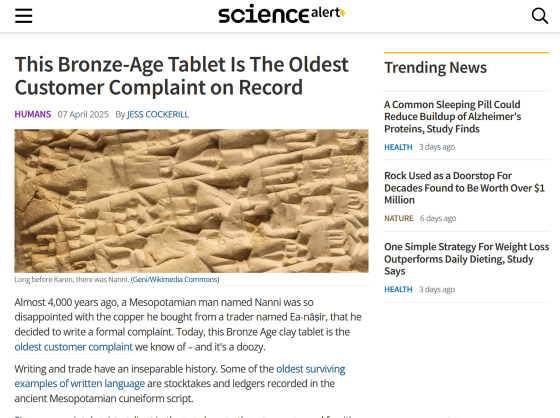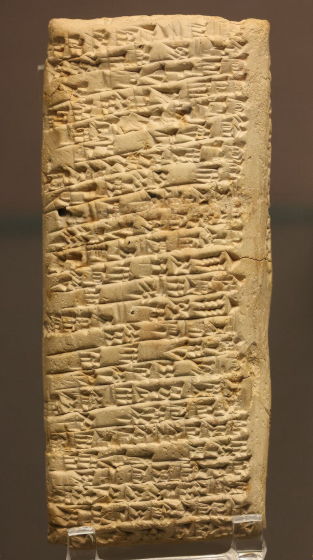The world's oldest customer complaint is written in cuneiform on an ancient Mesopotamian clay tablet

by Wikimedia Commons
Around 1750 BC during the Bronze Age, a man named Nanni, who lived in the ancient Mesopotamian city of
Oldest written customer complaint | Guinness World Records
https://www.guinnessworldrecords.com/world-records/537889-oldest-written-customer-complaint
This Bronze-Age Tablet Is The Oldest Customer Complaint on Record : ScienceAlert
https://www.sciencealert.com/this-bronze-age-tablet-is-the-oldest-customer-complaint-on-record

Writing and trade are deeply intertwined, and some of the oldest surviving cuneiform writing was used in ancient Mesopotamia to keep records of the buying and selling of goods.
In ancient Mesopotamia during the Bronze Age, as the name of the period suggests, bronze tools were the main tools used, and copper, the material used in making them, was an important commodity. As a result, there are many records of copper-related transactions, but sometimes troubles arose over copper transactions.
Nanni, who bought copper from a merchant named E'Nasir around 1750 BC, was one of the customers who was outraged when a messenger was given low-quality copper. Since there was no customer helpline at the time, Nanni wrote the details of his complaint on a clay tablet and gave it to a messenger to deliver to E'Nasir.
The photo below shows the 'clay tablet containing the complaint' that Nanni actually sent to E-Nasir. The tablet is about 11.6 cm x 5 cm in size, and both sides are densely filled with complaints to E-Nasir. This clay tablet was discovered during excavations in Ur (present-day southern Iraq) conducted from 1922 to 1934, at a site that is believed to be E-Nasir's residence.

The tablets were deciphered by American archaeologist Adolph Leo Oppenheim and reported on in his 1967 book , Letters From Mesopotamia .
Nanni wrote on the tablet, 'You placed inferior (copper) ingots before my messengers and said, 'Take it if you want, or leave if you don't.'' It seems likely that Nanni's messengers had already paid E'nasir for the copper as agreed upon, but were only given inferior copper by E'nasir.
The tablet also contained an inscription expressing his intense anger: 'What do you think of me, that you treat me with such contempt? I have sent our gentlemen as messengers to retrieve the bags of money I entrusted to you, but you have shown me contempt by sending me back empty-handed and even through enemy lands. Who among the merchants trading with Telmun would treat me like this? You alone treat my messengers with contempt!'
The Tilmun mentioned here is thought to be the same as Dilmun , a trading partner of ancient Mesopotamia and known as a copper producing or trading site. Tilmun copper was dominant in ancient Mesopotamia for a long time at that time, but it had begun to decline just around the time Nanni wrote his complaint, and had been overtaken by a competing copper supplier called Magan . Other clay tablets with complaints written on them have been excavated from Eanasir's residence, and it is possible that these were affected by the decline of Tilmun copper, which they were trading with.
At the end of the tablet, Nanni informed E'Anassir, 'Now it is up to you to pay me back in full. Be aware that from now on I will not accept any copper here from you that is not of good quality. I will take selected ingots individually from my own premises, and as you have treated me with contempt I will exercise my right of refusal against you.'
Related Posts:
in Note, Posted by log1h_ik







